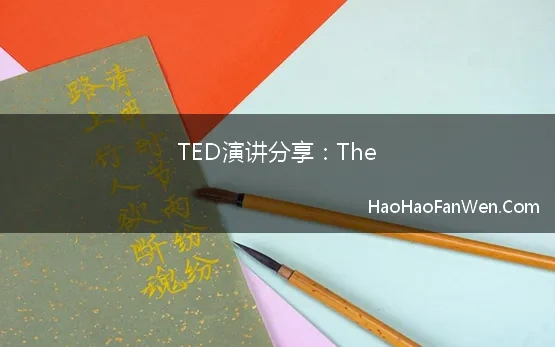关于肤色歧视的演讲(TED精彩演讲:肤色的科学——肤色绝不反映人的品格)
下面是好好范文网小编收集整理的关于肤色歧视的演讲(TED精彩演讲:肤色的科学——肤色绝不反映人的品格),仅供参考,欢迎大家阅读!

美国明尼苏达州, 非裔男子乔治·弗洛依德因美国警察暴力执法而窒息死亡,就此诱发了全美乃至全球的反种族歧视游行示威活动。
不可否认,种族歧视是美国历史上由来已久的议题。如今弗洛依德事件把这一议题再次摆到人们眼前。它就像房间里的一头大象一样,人们无法做到忽视它。
今天东方君不想谈这一沉重深远的历史议题,而是想通过TED的一篇演讲,从科学的角度跟大家聊一聊人的肤色差异的原因。
When ultraviolet sunlight hits our skin, it affects each of us a little differently. Depending on skin color, it will take only minutes of exposure to turn one person beetroot-pink, while another requires hours to experience the slightest change. So what‘s to account for that difference and how did our skin come to take on so many different hues to begin with?
当紫外线照射我们的皮肤时,每个人都会受到些许不同的影响。由于肤色差异,有些人暴晒几分钟就被晒成像甜菜根似的粉红色,而有些人暴晒几小时才稍有变化。那么该如何解释这种差异呢? 我们的皮肤又是怎样开始呈现出许多不同色调的呢?
Whatever the color, our skin tells an epic tale of human intrepidness and adaptability, revealing its variance to be a function of biology. It all centers around melanin, the pigment that gives skin and hair its color.
无论什么颜色的皮肤,都是人类史诗般强大的适应性和无畏精神的见证, 肤色的多样性是一项生物学功能。一切都得围绕黑色素说起。正是它赋予了皮肤与毛发相应的色泽。
This ingredient comes from skin cells called melanocytes and takes two basic forms.There's eumelanin, which gives rise to a range of brown skin tones, as well as black, brown, and blond hair, and pheomelanin, which causes the reddish browns of freckles and red hair.
黑色素产生于一种皮肤细胞,即黑色素细胞。它有两种基本形式:一种是真黑素,负责形成一系列棕色调皮肤以及黑棕和金色毛发;另一种是褐黑素,负责形成红棕色雀斑与红色毛发。
But humans weren't always like this. Our varying skin tones were formed by an evolutionary process driven by the Sun.
但人类曾经并非一直如此。 是太阳促使人类在进化过程中演变出了不同的肤色。
It began some 50,000 years ago when our ancestors migrated north from Africa and into Europe and Asia. These ancient humans lived between the Equator and the Tropic of Capricorn, a region saturated by the Sun's UV-carrying rays. When skin is exposed to UV for long periods of time, the UV light damages the DNA within our cells, and skin starts to burn. If that damage is severe enough, the cells mutations can lead to melanoma, a deadly cancer that forms in the skin's melanocytes.
这场进化开始于大约五万年前,从我们的祖先由非洲北迁至欧亚大陆开始。 那时远古人类生活在赤道与南回归线之间,一个充满强紫外线的地方。他们的皮肤长期暴露在紫外线下,紫外线会破坏细胞内的DNA并灼伤皮肤。当DNA受到严重破坏时,会使细胞突变导致黑色素瘤,一种由黑色素细胞形成的致命癌症。
Sunscreen as we know it today didn't exist 50,000 years ago. So how did our ancestors cope with this onslaught of UV?
我们今天所知的防晒霜,五万年前并不存在。 那么我们祖先是如何抵抗强烈的紫外线照射呢?
The key to survival lay in their own personal sunscreen manufactured beneath the skin: melanin.The type and amount of melanin in your skin determines whether you'll be more or less protected from the sun. This comes down to the skin's response as sunlight strikes it. When it's exposed to UV light, that triggers special light-sensitive receptors called rhodopsin, which stimulate the production of melanin to shield cells from damage.
他们存活的关键在于他们自身产生的皮下防晒霜:黑色素。黑色素的种类决定了皮肤受到保护程度的大小。黑色素实质上是皮肤对日照作出的反应。当紫外线照射皮肤时会触发名为视紫质的光敏受体,它可以刺激黑色素产生从而保护细胞免受伤害。
For light-skin people, that extra melanin darkens their skin and produces a tan. Over the course of generations, humans living at the Sun-saturated latitudes in Africa adapted to have a higher melanin production threshold and more eumelanin, giving skin a darker tone. This built-in sun shield helped protect them from melanoma, likely making them evolutionarily fitter and capable of passing this useful trait on to new generations.
对肤色浅的人来说过量黑色素会使肤色加深呈现出棕褐色。数代之后,生活在阳光充沛的赤道地区周围的非洲居民进化出了更高的黑色素产生阈值,同时分泌出更多的真黑素,加深了皮肤的色调。 这种内置遮阳罩保护了他们免受黑色素瘤的侵害,他们进化得更加适应生存环境,同时将这种有用的特征遗传给下一代。
But soon, some of our Sun-adapted ancestors migrated northward out of the tropical zone, spreading far and wide across the Earth. The further north they traveled, the less direct sunshine they saw.
可是不久, 一些适应了强紫外线的居民开始北上,逐渐离开热带区域分散到世界各地。
他们越往北走接触到的太阳直射就越少。
This was a problem because although UV light can damage skin, it also has an important parallel benefit. UV helps our bodies produce vitamin D, an ingredient that strengthens bones and lets us absorb vital minerals, like calcium, iron, magnesium, phosphate, and zinc. Without it, humans experience serious fatigue and weakened bones that can cause a condition known as rickets.
那么问题来了, 紫外线虽然伤害皮肤,但是它有一个相当重要的好处。紫外线可以帮助身体产生维生素D,来强化我们骨骼,并辅助钙、铁、镁、磷、锌等重要矿物的吸收。缺乏它人们会疲劳乏力且骨质疏松进而导致佝偻病。
For humans whose dark skin effectively blocked whatever sunlight there was, vitamin D deficiency would have posed a serious threat in the north. But some of them happened to produce less melanin. They were exposed to small enough amounts of light that melanoma was less likely, and their lighter skin better absorbed the UV light. So they benefited from vitamin D, developed strong bones, and survived well enough to produce healthy offspring. Over many generations of selection, skin color in those regions gradually lightened.
虽然深色皮肤可以帮助北方人有效阻挡任何强度的阳光直射,但是维生素D的缺乏对他们造成威胁。不过正好有些人产生较少的黑色素。他们暴露在少量但是充足的阳光下,不仅能避免黑色素瘤的形成,还能更好地吸收紫外线。得益于充足维生素D的合成,他们的骨骼更加强壮,而且更有利于生存抚育健康的后代。 多代筛选后,北方居民肤色逐渐变浅。
As a result of our ancestor's adaptability, today the planet is full of people with a vast palette of skin colors, typically, darker eumelanin-rich skin in the hot, sunny band around the Equator, and increasingly lighter pheomelanin-rich skin shades fanning outwards as the sunshine dwindles. Therefore, skin color is little more than an adaptive trait for living on a rock that orbits the Sun.
由于祖先们超强的适应能力,如今世界上遍布了各种肤色的人。通常真黑素较多的深色人种,生活在赤道周围阳光充沛的炎热地区;而褐黑素较多的浅色人种,因光照自赤道向外呈扇形递减肤色也逐渐变浅。因此肤色不过是人类为适应地球绕日运行而具有的适应性特征。
It may absorb light, but it certainly does not reflect character.
它可以吸收阳光,但绝不会反映品格。















